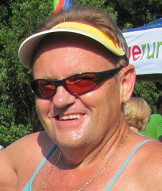Muscle cramps are disabling, involuntary spasms that may occur during training or racing, most often in the large muscles of the lower leg, although they can occur anywhere. Some runners or walkers will always get cramps provided they run/walk far enough while others are almost never affected. Cramping due to exertion tend to occur in runners/walkers who run/walk further or faster than they do in training.
Free radical production during exercise (or due to excessive lactic acid build up) may contribute to muscle fatigue, possibly leading to muscle cramps.
What can you do?
Risk factors for cramping may include older age, higher body mass index, longer running/walking history, no stretching, and a genetic inclination to cramping (family history). Exercise-related activities viz. hard running/walking, muscle fatigue, hills, and long-distance running/walking also contribute to the development of cramps. The following can however reduce the risk of cramping:
- Do more training, especially long distance runs if you run/walk marathons and longer races. On race day, running/walking faster or farther than you have trained will overwhelm your muscles making them more susceptible to cramps.
- Do not run/walk too fast early in the race.
- Adequate pre-race stretching is very important provided that you normally do stretch.
- Attention to adequate fluid (take note that an excessive fluid intake may dilute the amount of sodium in the blood (hyponatraemia) which could lead to cramping), and carbohydrate replacement before and during exercise. It is important to stay well hydrated since it may lessen the severity of the cramps.
- If you cramp while you are sleeping it may be due to a relative magnesium deficiency. Take a magnesium supplement to rectify the deficiency and take a magnesium/calcium supplements on a regular basis. There are also different formulations on the market specially formulated to prevent cramping. Experiment with these and see which one works for you.
- Take on a regular base a good multi-vitamin/mineral supplement rich in antioxidants to keep the free radicals in check.
- Take a supplement that is capable of buffering lactic acid during training or racing.
- The most effective form of prevention for cramps is to undertake a regular stretching programme that focuses especially on the muscles that are prone to cramp during exercise.
Even if you take the necessary precautions, cramps may still strike. To prevent injury to the muscle, stop running/walking immediately and stretch the affected muscle. Stretching helps relax the spasm; you may however have to stop and stretch a number of times before the cramp abates. In order to provide relief, apply deep pressure at the site of the cramp by pressing with your fingers into the affected muscle and hold for 10 to 15 seconds. Icing the area may also be of benefit.
It is also important to drink a fluid with electrolytes - sports drinks that contain electrolytes can help resolve cramps as well as prevent them. About an hour or two before the run/walk take 450 ml of fluid and then between 150 and 350 ml every 15 to 20 minutes during the run.
When you start cramping, slow down for a while. If the muscle is sensitive after the race use an anti-inflammatory, ice and rest.
REFERENCES
- Schwellnus, M.P. 1999. Skeletal muscle cramps during exercise. Physician and Sportsmedicine, 27 (November): 109-115.
- Noakes, T. 2001. Lore of Running, Fourth Edition. Oxford University Press Southern Africa, Cape Town.
Coach Rossouw


 RSS Feed
RSS Feed